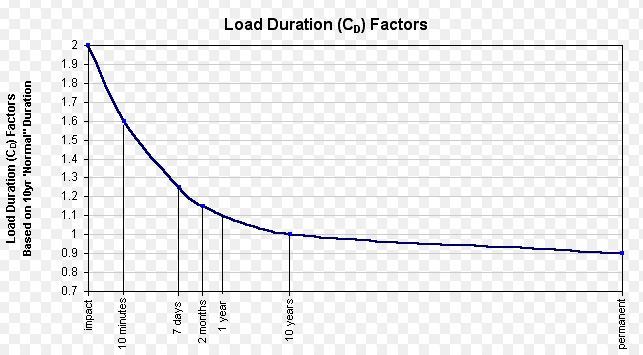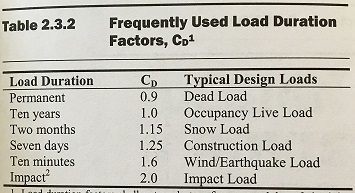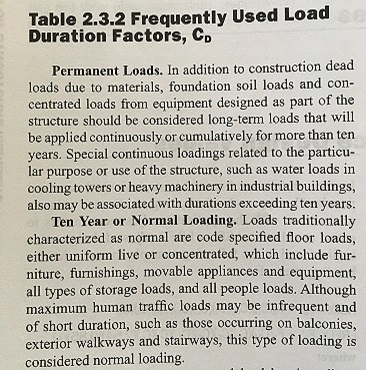(location = USA - IBC building code using the NDS wood specification)
So we've got an exterior wood framed deck that is adjacent to and serves a dining room in a commercial building.
Per code - dining room's live load = 100 psf. Per code, the deck "serves" the dining room so it's live load is 100 psf as well.
The design of the wood joists supporting the composite decking of this deck structure would typically use a duration of load factor of 1.0 for "live loads".
However, typical live loads, say in an office or residence, are usually somewhat sustained over time much more than a deck area serving a dining area.
We can imagine multiple uses of the deck over time where the actual live load would be on the order of 30 to 50 psf. However, for a 100 psf load application,
it seems that the duration of that type of load (large crowd of people gathered at an event) would be more like a snow load application - not occurring all that often or
for all that much time.
Would it be appropriate to utilize the actual load duration curve from the NDS commentary and apply perhaps a Cd factor of 1.10 or 1.15 to this 100 psf live load?
And then perhaps look at Cd = 1.0 with a live load of 50 psf as well?
Check out Eng-Tips Forum's Policies here:
faq731-376
So we've got an exterior wood framed deck that is adjacent to and serves a dining room in a commercial building.
Per code - dining room's live load = 100 psf. Per code, the deck "serves" the dining room so it's live load is 100 psf as well.
The design of the wood joists supporting the composite decking of this deck structure would typically use a duration of load factor of 1.0 for "live loads".
However, typical live loads, say in an office or residence, are usually somewhat sustained over time much more than a deck area serving a dining area.
We can imagine multiple uses of the deck over time where the actual live load would be on the order of 30 to 50 psf. However, for a 100 psf load application,
it seems that the duration of that type of load (large crowd of people gathered at an event) would be more like a snow load application - not occurring all that often or
for all that much time.
Would it be appropriate to utilize the actual load duration curve from the NDS commentary and apply perhaps a Cd factor of 1.10 or 1.15 to this 100 psf live load?
And then perhaps look at Cd = 1.0 with a live load of 50 psf as well?
Check out Eng-Tips Forum's Policies here:
faq731-376

![[idea] [idea] [idea]](/data/assets/smilies/idea.gif)
![[r2d2] [r2d2] [r2d2]](/data/assets/smilies/r2d2.gif)
![[peace] [peace] [peace]](/data/assets/smilies/peace.gif)


